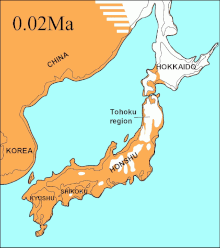| Revision as of 20:50, 24 June 2013 editYngvadottir (talk | contribs)Autopatrolled, Extended confirmed users50,686 edits Identified sources, moving one statement and ref out of lede, added one, removed unsupported statement about Home Islands not being used in reference to the country today, changed template to refimprove.← Previous edit | Revision as of 21:12, 6 September 2013 edit undo68.63.183.99 (talk)No edit summaryNext edit → | ||
| Line 2: | Line 2: | ||
| ] of Japan]] | ] of Japan]] | ||
| ] | ] | ||
| The {{nihongo|'''Japanese archipelago'''|日本列島|Nihon Rettō}} are the islands that form the country of Japan, extends roughly from northeast to southwest along the northeastern coast of the ] mainland, washing upon the northwestern shores of the ]. It consists of islands from the ] and the ]. | The {{nihongo|'''Japanese archipelago'''|日本列島|Nihon Rettō}} are the islands that form the country of Japan, and extends roughly from northeast to southwest along the northeastern coast of the ] mainland, washing upon the northwestern shores of the ]. It consists of islands from the ] and the ]. | ||
| The term ''Home Islands'' was used at the end of ] to define the area of Japan to which its sovereignty and the constitutional rule of the ] would be restricted.{{citation needed|date=June 2013}} The term is also commonly used today to distinguish the archipelago from Japan's colonies and other territories in the first half of the 20th century.<ref>Milton W. Meyer, ''Japan: A Concise History'', 4th ed. Lanham, Maryland: Rowman & Littlefield, 2012, ISBN 9780742541184, .</ref> | The term ''Home Islands'' was used at the end of ] to define the area of Japan to which its sovereignty and the constitutional rule of the ] would be restricted.{{citation needed|date=June 2013}} The term is also commonly used today to distinguish the archipelago from Japan's colonies and other territories in the first half of the 20th century.<ref>Milton W. Meyer, ''Japan: A Concise History'', 4th ed. Lanham, Maryland: Rowman & Littlefield, 2012, ISBN 9780742541184, .</ref> | ||
Revision as of 21:12, 6 September 2013
| This article needs additional citations for verification. Please help improve this article by adding citations to reliable sources. Unsourced material may be challenged and removed. Find sources: "Japanese archipelago" – news · newspapers · books · scholar · JSTOR (June 2013) (Learn how and when to remove this message) |


The Japanese archipelago (日本列島, Nihon Rettō) are the islands that form the country of Japan, and extends roughly from northeast to southwest along the northeastern coast of the Eurasia mainland, washing upon the northwestern shores of the Pacific Ocean. It consists of islands from the Sakhalin island arc and the Northeastern Japan arc.
The term Home Islands was used at the end of World War II to define the area of Japan to which its sovereignty and the constitutional rule of the Emperor would be restricted. The term is also commonly used today to distinguish the archipelago from Japan's colonies and other territories in the first half of the 20th century.
Island components
The archipelago consists of 6,852 islands ("island" defined as land more than 100 m in circumference), of which 430 are inhabited. The four main islands, from north to south, are Hokkaido, Honshu, Shikoku, and Kyushu; Honshu is the largest and referred to as the Japanese mainland.
Palaeogeography
Main articles: Sea of Japan § Geography and geology, and Japanese PaleolithicChanges to the Japanese archipelago over time:



| – regions above sea level | |
| (white color) – unvegetated land | |
| – sea |
See also
References
- Milton W. Meyer, Japan: A Concise History, 4th ed. Lanham, Maryland: Rowman & Littlefield, 2012, ISBN 9780742541184, p. 2.
- "Islands in Abundance", Look Japan Volume 43, Issues 493–504, p. 37.
- "Japanese Archipelago", TheFreeDictionary.com, retrieved 24 June 2013.
External links
This Japanese location article is a stub. You can help Misplaced Pages by expanding it. |